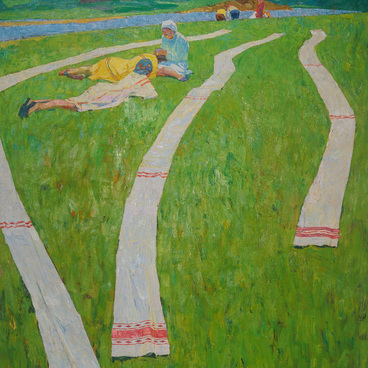The national theme in the works of the talented artist Alexander Alexandrovich Rodionov is reflected in female images. He emphasized the special physique of the Mordovian women: their leisurely walk and smooth gestures. Rodionov’s keen eye of the artist penetrates into the essence of the character, the spirit of the whole nation and brings the image to the monumental, archetypal level.
One of the paintings, which vividly represents the Mordovian character, is an unfinished canvas by Rodionov “Kolkhoz Woman”. It is distinguished by the sketchy, free manner of execution. An elderly woman in a red national Mordovian costume and white kerchief is depicted against a neutral background. The national identity of the character — she is a Moksha woman — can be inferred from the casual dress with a yoke, brightly decorated with ribbons. It is complemented by a bib apron with ruffles on the sides. It is in the national costume that folk ideas of beauty, ethical norms and aesthetic ideals are reflected.
The image is full of incredible dignity. It is not just a portrait of a mature Moksha woman, it is an image of character. The woman in the picture is like one of the many Mordovian mother goddesses. The static, monumental figure emphasizes the earthly appearance, and gives the woman a resemblance to Mastorava (“mastor” — earth, “ava” — mother). This woman is the salt of the earth, a laborer who had a hard lot on her shoulders. The sun did not spare her in the fields, leaving traces on her face and her toil-laden hands.
The artist celebrates the beauty of a simple peasant woman, using an incredible abundance of color. The freshness, brightness of paints, their impetuous whirlwind charms the viewer even today. Rodionov feels well the peculiarities of the national character of people’s life, he appeals to the traditional color scheme. Hot, sonorous red is chosen here as the highest note, as a symbolic color of life, powerful people’s vitality and joy of being. All other colors only supplement and enhance this effect. The wide and open manner of painting also corresponds to this; the stroke is bold and dynamic. The woman’s figure looks enormous, standing out clearly against the pale yellow background. Monumental equilibrium and frontal composition only enhance this effect. The artist admires the Mordovian woman’s figure, the clean line of her face, her maternal tenderness and light cheerfulness. He captures the very core, the pure essence of peasant women — strong, and somewhat mighty, but beautiful in their overwhelming power.
One of the paintings, which vividly represents the Mordovian character, is an unfinished canvas by Rodionov “Kolkhoz Woman”. It is distinguished by the sketchy, free manner of execution. An elderly woman in a red national Mordovian costume and white kerchief is depicted against a neutral background. The national identity of the character — she is a Moksha woman — can be inferred from the casual dress with a yoke, brightly decorated with ribbons. It is complemented by a bib apron with ruffles on the sides. It is in the national costume that folk ideas of beauty, ethical norms and aesthetic ideals are reflected.
The image is full of incredible dignity. It is not just a portrait of a mature Moksha woman, it is an image of character. The woman in the picture is like one of the many Mordovian mother goddesses. The static, monumental figure emphasizes the earthly appearance, and gives the woman a resemblance to Mastorava (“mastor” — earth, “ava” — mother). This woman is the salt of the earth, a laborer who had a hard lot on her shoulders. The sun did not spare her in the fields, leaving traces on her face and her toil-laden hands.
The artist celebrates the beauty of a simple peasant woman, using an incredible abundance of color. The freshness, brightness of paints, their impetuous whirlwind charms the viewer even today. Rodionov feels well the peculiarities of the national character of people’s life, he appeals to the traditional color scheme. Hot, sonorous red is chosen here as the highest note, as a symbolic color of life, powerful people’s vitality and joy of being. All other colors only supplement and enhance this effect. The wide and open manner of painting also corresponds to this; the stroke is bold and dynamic. The woman’s figure looks enormous, standing out clearly against the pale yellow background. Monumental equilibrium and frontal composition only enhance this effect. The artist admires the Mordovian woman’s figure, the clean line of her face, her maternal tenderness and light cheerfulness. He captures the very core, the pure essence of peasant women — strong, and somewhat mighty, but beautiful in their overwhelming power.




